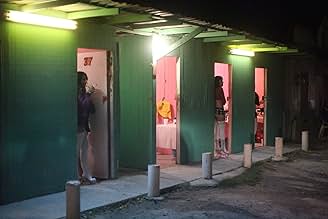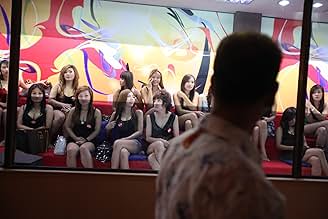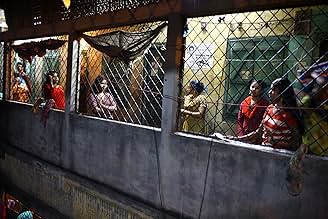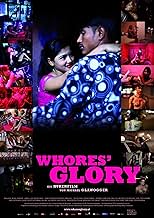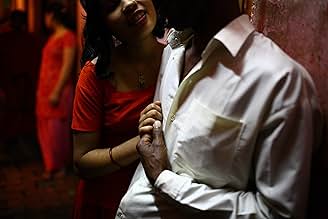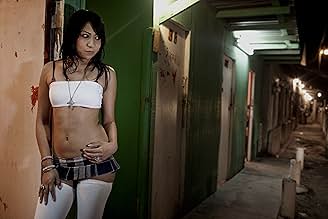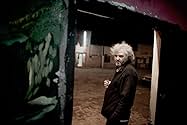AVALIAÇÃO DA IMDb
7,2/10
5,4 mil
SUA AVALIAÇÃO
Adicionar um enredo no seu idiomaAn examination of the lives, needs, troubles, and hopes of prostitutes in Thailand, Bangladesh, and Mexico.An examination of the lives, needs, troubles, and hopes of prostitutes in Thailand, Bangladesh, and Mexico.An examination of the lives, needs, troubles, and hopes of prostitutes in Thailand, Bangladesh, and Mexico.
- Direção
- Roteirista
- Artistas
- Prêmios
- 3 vitórias e 5 indicações no total
Avaliações em destaque
Might be my favorite documentary of all time - it really makes you feel the sorrow behind these poor women.
I wasn't sure what to expect when my wife picked out this movie to watch but man was this movie ever thought provoking and interesting. What makes the film unique is that there is no narration or cuts to "experts" and hardly any interviews. The camera is more or less a fly on the wall. The only negative this is that the depressing music is cranked a little too high in the mix and is really obtrusive at times.
The movie covers prostitution in Thailand, Bangladesh and Mexico. The documentary in specific looks at a midrange operation in Thailand and a sad and depressing filthy brothel in Bangladesh with young girls, and a low rent operation in Mexico. The movie is very effective.
Some complain that he isn't painting a fair picture of prostitution leaving out the nice clubs in Amsterdam and Nevada. In fact in the Mexican town you can see a big building in many scenes with the word Lipstick on it. This is a nice strip club with good looking girls who you can take upstairs for about five times what the girls who make it into the documentary charge, but instead he shows a sorry strip club with very disturbing looking girls and the low rent section of the Tolerance Zone with crack ladies of the night.
If he just showed the glitzy brothels, this movie wouldn't have nearly the same impact as it does. The Thai joint is the only glitzy joint here with hairdressers and makeup people dolling them up before the night. The Bangladesh and Mexican places don't even have running water and the girls are lucky if they even have a mirror.
Bottom line: this movie is really great. Even my wife liked it and she usually hates documentaries and anything with subtitles... I am glad that she picked it out. Only the music detracts from this moving documentary.
The movie covers prostitution in Thailand, Bangladesh and Mexico. The documentary in specific looks at a midrange operation in Thailand and a sad and depressing filthy brothel in Bangladesh with young girls, and a low rent operation in Mexico. The movie is very effective.
Some complain that he isn't painting a fair picture of prostitution leaving out the nice clubs in Amsterdam and Nevada. In fact in the Mexican town you can see a big building in many scenes with the word Lipstick on it. This is a nice strip club with good looking girls who you can take upstairs for about five times what the girls who make it into the documentary charge, but instead he shows a sorry strip club with very disturbing looking girls and the low rent section of the Tolerance Zone with crack ladies of the night.
If he just showed the glitzy brothels, this movie wouldn't have nearly the same impact as it does. The Thai joint is the only glitzy joint here with hairdressers and makeup people dolling them up before the night. The Bangladesh and Mexican places don't even have running water and the girls are lucky if they even have a mirror.
Bottom line: this movie is really great. Even my wife liked it and she usually hates documentaries and anything with subtitles... I am glad that she picked it out. Only the music detracts from this moving documentary.
This documentary was nowhere near as interesting as it could have been. Why? Well because we never really got a real glimpse into the lives and existences of the prostitutes portrayed in the documentary.
The documentary is divided into three segments; "The Fishtank" in Bangkok/Thailand, "The City of Joy" in Faridpur/Bangladesh, and finally "The Zone" in Reynosa/Mexico.
"The Fishtank" proved to be the most 'glamorous' of the places shown and of the three segments. Now, the word is being used in a less than positive way, mind you. Here the women sit on display behind a wall of glass for the patrons in the bar to gawk and pick from, calling out their numbers when they settle on a woman. This segment was also the least interesting, because it basically told no story of the women working there. It was all just about showing how the business worked at that given location.
"The City of Joy" was the most downtrodden and depressing of the segments. However, this was also where the director actually started to step up and show the story of some of the women working there. The conditions shown here were just atrocious, and there were even little children living in the environment. The milieu here was really harsh and gray.
"The Zone" turned out to be the must 'in-your-face' segment, in the terms that we we got to see the conditions the women were working under and also showed that drugs was, of course, a part of life in "The Zone". This segment also allowed the viewers to get to become acquainted with some of the women there. Be warned though, that this segment does hold some sexual graphic scenes, which might not just be suitable for anyone.
I had expected to actually get a better insight in the world of prostitution and the world these people live in. But at almost 2 hours, this documentary proved to be very little educational. And as the end credits started to roll on the screen, I must admit that I sat there thinking "what was the purpose of this?". Director Michael Glawogger veered right away from anything that really could pass as educational and proper documentary.
I just love the irony of how the synopsis claims: "The documentary revolves around the lives and individual hopes, needs and experiences of the women." This is such a stretch and can hardly pass as being proper information about the contents.
If you enjoy documentaries about the shadier sides of life, then chances are that your time is much better spent elsewhere.
The documentary is divided into three segments; "The Fishtank" in Bangkok/Thailand, "The City of Joy" in Faridpur/Bangladesh, and finally "The Zone" in Reynosa/Mexico.
"The Fishtank" proved to be the most 'glamorous' of the places shown and of the three segments. Now, the word is being used in a less than positive way, mind you. Here the women sit on display behind a wall of glass for the patrons in the bar to gawk and pick from, calling out their numbers when they settle on a woman. This segment was also the least interesting, because it basically told no story of the women working there. It was all just about showing how the business worked at that given location.
"The City of Joy" was the most downtrodden and depressing of the segments. However, this was also where the director actually started to step up and show the story of some of the women working there. The conditions shown here were just atrocious, and there were even little children living in the environment. The milieu here was really harsh and gray.
"The Zone" turned out to be the must 'in-your-face' segment, in the terms that we we got to see the conditions the women were working under and also showed that drugs was, of course, a part of life in "The Zone". This segment also allowed the viewers to get to become acquainted with some of the women there. Be warned though, that this segment does hold some sexual graphic scenes, which might not just be suitable for anyone.
I had expected to actually get a better insight in the world of prostitution and the world these people live in. But at almost 2 hours, this documentary proved to be very little educational. And as the end credits started to roll on the screen, I must admit that I sat there thinking "what was the purpose of this?". Director Michael Glawogger veered right away from anything that really could pass as educational and proper documentary.
I just love the irony of how the synopsis claims: "The documentary revolves around the lives and individual hopes, needs and experiences of the women." This is such a stretch and can hardly pass as being proper information about the contents.
If you enjoy documentaries about the shadier sides of life, then chances are that your time is much better spent elsewhere.
Whore's Glory is a documentary about prostitution. There is no voice over, no narration, no script. It merely records a visual documentation of the lives of prostitutes in three different venues (located in Thailand, Bangladesh and Mexico).
Of course the film was edited, but other than that, it provides an unfiltered view of prostitution. It focuses on the prostitutes themselves, enough so that the viewer sees the conditions they live in/under. They sometimes talk to the camera. We learn of their sorrows, their problems, and how they deal with the realities of prostitution.
In Thailand, the girls do not seem as victimized. Oddly, some of them spend much of their money on the "bar boys" who entertain women for money.
In Bangladesh, these women are truly victims of economic hardship. Women bring their daughters into the business. Society is so stratified that people's choices are limited. The caste system still controls much of life there.
Because the camera is just an observer, there is no glorification of the job. In all three locations, waiting is a large part of the job. Religion and superstitious mysticism play a part in the women's lives, just as for others in their societies.
One woman in Bangladesh who comes across as more sensitive, perhaps more intelligent explains the horrible reality she must confront every day, saying "Women are unhappy creatures." Philosophically, she wonders why it is that way and how it can change.
Of course the film was edited, but other than that, it provides an unfiltered view of prostitution. It focuses on the prostitutes themselves, enough so that the viewer sees the conditions they live in/under. They sometimes talk to the camera. We learn of their sorrows, their problems, and how they deal with the realities of prostitution.
In Thailand, the girls do not seem as victimized. Oddly, some of them spend much of their money on the "bar boys" who entertain women for money.
In Bangladesh, these women are truly victims of economic hardship. Women bring their daughters into the business. Society is so stratified that people's choices are limited. The caste system still controls much of life there.
Because the camera is just an observer, there is no glorification of the job. In all three locations, waiting is a large part of the job. Religion and superstitious mysticism play a part in the women's lives, just as for others in their societies.
One woman in Bangladesh who comes across as more sensitive, perhaps more intelligent explains the horrible reality she must confront every day, saying "Women are unhappy creatures." Philosophically, she wonders why it is that way and how it can change.
The film is interesting and powerful, albeit depressing. No idea how the director got access to give us such a candid look, but this is a dark side of the world you won't see anywhere else. The subject is self explanatory, if you're at all interested about the lives of these women in Thailand, Bangladesh, and Mexico then you should experience this.
My one critique is thematically, the movie is about prostitution in abject poverty, not prostitution as a "job", but does not make any distinction. The prostitutes in Bangladesh and Mexico he shows were in absolutely horrifying conditions - they were forced into it, threatened if they tried to leave, and barely paying for food. Whereas in Amsterdam, Germany, and even many in Bangkok treat it as an occupational choice. They can get other jobs, but choose to do this. Those are two VERY different circumstances that can have very different effects on people physically and emotionally.
That would be my critique to keep in mind while watching. The movie is not so much a commentary on the evils of prostitution or even the lives of prostitutes, as it is delving into the darkest depth of what desperate conditions can bring.
My one critique is thematically, the movie is about prostitution in abject poverty, not prostitution as a "job", but does not make any distinction. The prostitutes in Bangladesh and Mexico he shows were in absolutely horrifying conditions - they were forced into it, threatened if they tried to leave, and barely paying for food. Whereas in Amsterdam, Germany, and even many in Bangkok treat it as an occupational choice. They can get other jobs, but choose to do this. Those are two VERY different circumstances that can have very different effects on people physically and emotionally.
That would be my critique to keep in mind while watching. The movie is not so much a commentary on the evils of prostitution or even the lives of prostitutes, as it is delving into the darkest depth of what desperate conditions can bring.
Você sabia?
- CuriosidadesWhores' Glory (2011) is the third and final part in Michael Glawogger's 'globalization trilogy', the other parts being Megacities (1998) and Trabalhos Mortais (2005).
- ConexõesFeatured in Docventures: Seksi (2013)
Principais escolhas
Faça login para avaliar e ver a lista de recomendações personalizadas
- How long is Whores' Glory?Fornecido pela Alexa
Detalhes
- Data de lançamento
- Países de origem
- Centrais de atendimento oficiais
- Idiomas
- Também conhecido como
- La gloria de las prostitutas
- Locações de filme
- Empresas de produção
- Consulte mais créditos da empresa na IMDbPro
Bilheteria
- Faturamento bruto nos EUA e Canadá
- US$ 31.420
- Fim de semana de estreia nos EUA e Canadá
- US$ 5.358
- 29 de abr. de 2012
- Faturamento bruto mundial
- US$ 197.932
- Tempo de duração
- 1 h 59 min(119 min)
- Cor
- Mixagem de som
- Proporção
- 1.85 : 1
Contribua para esta página
Sugerir uma alteração ou adicionar conteúdo ausente


